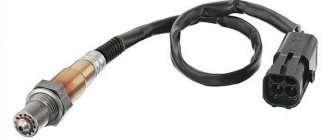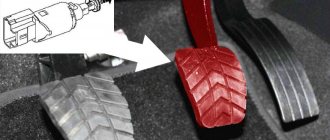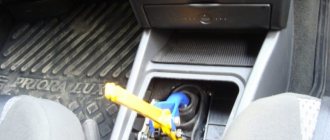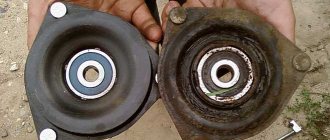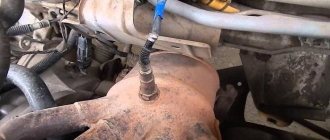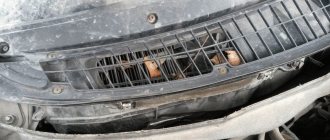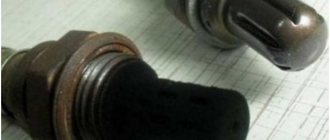Unfortunately, not all car owners know what a lambda probe is and why it is needed. A lambda probe is an oxygen sensor that allows the electronic system to monitor and balance the correct ratio of air and gasoline in the combustion chambers. It is able to promptly correct the structure of the fuel mixture and prevent destabilization of the engine operating process.
This rather fragile device is located in a very aggressive environment, so its operation must be constantly monitored, since if it breaks down, further use of the car is impossible. Periodic checking of the lambda probe will guarantee stable operation of the vehicle.
Types of sensors and operating principle
The lambda probe is installed in the exhaust system.
Sensors are divided into two types: two-point and broadband. The two-point sensor consists of ceramics, the elements of which are coated with zirconium dioxide on both sides. Installed in front of or behind the catalytic converter.
The principle of operation is to measure the level of oxygen concentration in the environment and exhaust gases. If the level changes and becomes different, a voltage is created at the ends of the sensor elements, from low to high. Low voltage is created if there is excess oxygen in the system.
Otherwise, if the system does not have the required level of oxygen, high voltage will be created. These signals are sent to the engine control unit, which distinguishes them by current strength.
The wideband sensor is a more modern design. It also has two ceramic elements. One of them can be called “pumping”. It is responsible for activating the process of pumping or removing air from the system.
The second element can be conventionally called “two-point”. The principle of operation is based on the fact that as long as there is the required amount of oxygen in the mixture, the current strength on the “pumping” element does not change and is transferred to the “two-point” element.
It, in turn, receiving a constant current from the “pumping” element, maintains a constant voltage between its elements and is inactive.
As soon as the oxygen level changes, the "pumping" element supplies the changed voltage to the "two-point". This, in turn, ensures either pumping air into the system or pumping it back.
Description of the device and where it is located
With the advent of electronic gasoline injection systems, designers were faced with the task of regulating the composition of the fuel mixture. For this they began to use oxygen sensors or lambda probes. The devices maintain the composition of the fuel mixture within certain limits, which ensures maximum efficiency of the catalytic converter. With other mixture compositions, the neutralizer begins to work incorrectly and fails.
Depending on the design of the exhaust system, one or two sensors are used:
- The first is installed directly in the exhaust manifold and measures the composition of the exhaust gases before the catalytic converter. In early systems this device was the only one.
- With the introduction of Euro-3 standards, a second probe began to be used, located after the neutralizer. The electronic control unit analyzes data from two sensors and indirectly evaluates the efficiency of the catalyst, also adjusting the composition of the mixture.
Lambda probe options
Manufacturers have established product shelf life:
- probe without heating coil - no more than 80 thousand km;
- heated unit - up to 100 thousand km;
- planar probes (broadband) - up to 160 thousand km.
The stated lifespan of the sensors is inaccurate. The service life of devices depends on many factors and may be lower or higher than the specified values.
Lambda probe on VAZ cars
Lada Priora Sedan Logbook Preparing for winter.
Starter VAZs use several types of sensors:
1. Bosch No. 0 258 005 133, Euro standard – 2. Installed on outdated models with an engine capacity of 1.5 liters. On later models with Euro 3 standard, this sensor was used as the first one, and was installed before the catalyst.
The second sensor was installed, which has a “return connector”. But you can find two identical sensors installed
2. Bosch No. 0 258 006537 was installed on cars manufactured since October 2004. They have a heating element in their structure.
Lambda probes produced are interchangeable with zirconium sensors of similar structure
Please note that a non-heated sensor can be replaced with a heated sensor. Not the other way around
Where to buy car accessories
Spare parts and other products for the car are easily available for purchase at auto stores in your city. But there is another option that has recently received significant improvements. You no longer need to wait a long time for a parcel from China: the AliExpress online store now offers the opportunity to ship from transshipment warehouses located in various countries. For example, when ordering, you can specify the “Delivery from the Russian Federation” option.
Follow the links and choose:
| Lambda probe, oxygen sensor for Lada Samara, Kalina, Priora | Eunavi s car alarm system, central kit with remote control | Car radar detector YASOKRO V7, 360 degrees |
| Radar detector Karadar STR G820 Led 2 in 1, radar detector with GPS | Auto radar detector 12V | Digital air/fuel ratio sensor Dynoracing for Lada Priora |
Oxygen sensor malfunctions and error codes
Lada Priora Sedan constructor, assemble it yourself Logbook Mileage and clutch replacement
Among the possible breakdowns of the lambda probe, the following can be distinguished: loss of sensitivity, non-working heating. As a rule, the on-board computer will not show you a breakdown if the problem is loss of sensitivity. It’s another matter if the heating circuit breaks, then the malfunction will be recorded.
- Error P1115 - a breakdown has occurred in the heating circuit
- Error P1102 - low resistance on the oxygen heater
- Error P0141 - the heater has broken down on the second sensor
- Error P0140 – sensor number two has broken
- Error P0138 - the second sensor indicates an excessive signal level
- Error P0137 - the second sensor indicates a reduced signal level
- Error P0136 – there is a short circuit to ground of the second sensor
- Error P0135 - the heater on the first sensor has failed
- Error P0134 – the first sensor has no signal
- Error P0133 - the first sensor responds slowly to the request
- Error P0132 – there is little oxygen in the system, the signal is high at the first sensor
- Error P0131 – there is a lot of oxygen in the system, the signal is low at the first sensor
- Error P0130 - the first sensor sends incorrect signals
How does a mechanic diagnose a P0041 code?
When diagnosing this error, the mechanic will do the following:
- Connects the OBD-II scanner to the vehicle's diagnostic connector
- Reads all stored data and error codes to find out when and under what circumstances the error occurred
- Clear the error codes from the computer's memory and test drive the vehicle to see if the P0041 code appears again
- If the error code appears again, visually inspect the oxygen sensor 2 connectors (bank 1 and bank 2) to see if they are reversed
- If the sensor connectors are connected properly, check the electrical wires for short circuits, open circuits, and damage.
- If no problem is found, check the engine control module (ECM) following the vehicle manufacturer's procedure
How to replace an oxygen sensor on a VAZ 2170-VAZ 2172
Lada Priora Sedan Logbook Replacing valve seals
When you come to a car shop or market, there will be a small but not small selection of oxygen sensors (If the store is specialized), some will come with a heating element, and some will not, Lada Priora cars are equipped with sensors with a heating element from the factory, therefore, when choosing, you will need to take exactly this one, it will be more expensive, but the whole point is as follows, the oxygen sensors begin to work normally only when they heat up to 300 ° C, at first, by the way, the car (Until it is warmed up) works at all according to other sensors, the oxygen sensor only comes into operation when it is warmed up and so that it does not warm up for a long time, this heating element is built into it, so don’t make a mistake when purchasing!
1) Both sensors, diagnostic and regulating, are removed in exactly the same way, so we will show an example of replacement at the top one. At the beginning, if the car is warm, let it cool completely, because at engine operating temperature, the temperature of the exhaust manifold reaches about 300- 500 °C, and maybe more if the car sneaks into traffic jams in warm weather and thereby warms up, after the engine has cooled down, remove the wire that is attached to it from the negative terminal of the battery (If you do not know how to do this, then study the article under title: “Replacing the battery”, everything is described there in point 1) and then press the lock, which is indicated by an arrow in the photo below, and disconnect the wire block and the connector that comes from the oxygen sensor.
2) Remove the following wire from the oxygen sensor from the heat-insulating shield, it is attached to it by a latch, to remove it, you just need to squeeze the latch (Latch) with your hands and remove it from the hole in the shield as shown in the first picture in the photo below and finally using a wrench or a special socket that can be found in a car store (a high socket with a split sector, it’s called, a very convenient thing, if you work with cars in the future, then purchase it, but if you are replacing it only for yourself then you don’t need it, because you can do it with a wrench) unscrew the oxygen sensor itself as shown in the second picture, in the photo below:
The new sensor is installed in its place in the reverse order of removal; by the way, we recommend lubricating the threads of the sensor with good graphite grease before installation.
Checking the oxygen sensor:
1. Any sensor, any part needs to be checked before running to the store and buying a new one. To check the oxygen sensor, you will need to stock up on a voltmeter and a paper clip, or a laptop and a diagnostic cable. Let’s first start by describing the first option, it is as follows: find the signal wire coming from the oxygen sensor on the connector, it can be of any color, but as a rule it goes black, so if you have a black wire, you can try to start with it, namely, to it you will need to connect the positive wire coming from the voltmeter (Through you need to connect a paperclip), and throw the negative wire to ground (the car engine can be the ground) and after starting the car, you will need to look at the readings that the voltmeter will give, they should not go beyond 1 and should not stand at 0, that is, in In the area of 0.01-0.99, the readings should fluctuate, if this is the case, then the sensor is working, but if the readings with the engine running freeze at any mark (For example, 0.32), then the sensor is faulty and needs to be replaced.
This method of verification, which is indicated in paragraph 1, by the way, is also shown in the video, which is posted below:
2. Now the second method, which is done using a laptop, and it consists of the following, connect the laptop to the brains of the car via a diagnostic connector and wire, then start it up and set all the data on the oxygen sensors on the laptop through the appropriate program and make sure that they fluctuate and do not stand in one place, you can see in more detail how to carry out this procedure using the example of a Lada Kalina car, as shown in the video clip below.
You can clearly see the process of removing this sensor from the exhaust manifold of a car in the video clip located just below:
Is it true that if you turn off the oxygen sensor and reflash the car, it will drive significantly better?
It won’t go much faster, but it will also depend on who stitched the car, in addition, emissions into the atmosphere from the exhaust pipe will worsen, that is, they will be dirtier and thus the environment will suffer from this!
Instructions for replacing the sensor yourself
Before starting work, you need to prepare materials and tools:
- New probe.
- A wrench or bit that will allow you to unscrew the sensor housing from the manifold. On some vehicles, you may be able to attempt to remove the device using a 22mm wrench or a gas adjustable wrench. But most machines require the use of specialized attachments.
- Extension for nozzle.
- Torque wrench up to 50-100 N/m.
- Protective gloves and sleeves, since the work is carried out on a heated collector.
- Heat shield and/or manifold removal wrenches.
Lambda probes should be replaced with the same or similar model with suitable parameters. The first available sensor cannot be installed. Before installation, you must carefully study the manufacturer's instructions.
An approximate sequence of actions when replacing the first probe:
- Heat the power supply to operating temperature. In this case, thermal expansion of the exhaust system elements occurs, which makes it easier to unscrew the sensor from the manifold or exhaust pipe.
- Turn off the engine.
- We remove the terminal from the battery to prevent the electric cooling fan from starting.
- Carefully disconnect the sensor connector from the harness.
- Wear protective gloves and remove the probe wire from the clamps.
- Unscrew the probe using the nozzle. At this stage, difficulties are possible, since the junction of the probe and the collector is clogged with rust and burnt grease. To facilitate the process, you can use local heating with a gas burner to burn off the rust. After this, you should try to remove the probe from its place; if the part does not begin to unscrew, repeat heating again.
- Clean the installation site from any remaining old graphite grease.
- Check that the threads of the new probe are regularly lubricated. The tool may be included in the package in a separate bag. The lubricant is applied to the threads in a thin and even layer. It is strictly prohibited to apply it to the protective cap, as this leads to the formation of hard deposits and deterioration of the probe’s performance. If your vehicle uses a sensor with two bolts, they do not require lubrication.
- Carefully screw the sensor by hand until it stops.
- Tighten the probe with a wrench to the required torque. Most manufacturers indicate a strength of 40-45 N/m, but it is recommended to clarify the value based on service literature. In the absence of a torque wrench, tightening is carried out by turning the probe 180 ° after manually tightening it until it stops.
- Place the tourniquet on the clamps and secure with ties if necessary.
- We connect the battery and clear errors from the control unit. Errors can be resolved using a computer or another method (depending on the make and model of the car).
When installing the probe, the tightening torque must be observed. Excessive force leads to destruction of the probe body or stripping of threads, low torque leads to exhaust gas leakage and uneven heating of the part.
The principle of operation of an oxygen sensor on a car
This sensor also has another name. Lambda probe, what kind of design is it and where did the name come from? The sensor is based on a ceramic solid electrolyte made of zirconium dioxide, which is in turn coated with yttrium oxide. In total, conductive, porous platinum electrodes are sprayed on top of the ceramic element.
The principle of operation is similar to that of a galvanic cell. After installation in the exhaust manifold, it heats up in the exhaust gas flow to 400 - 300 degrees. It is in the heated state that the zirconium electrolyte acquires conductivity and ensures its normal functioning. The lambda probe is installed in such a way that one of the electrodes breathes external air - a mixture of exhaust gases. When the amount of oxygen changes on one of the electrodes, a potential difference occurs, which is transmitted in the form of a signal to the engine control system, which regulates the fuel supply in a scientific manner.
In injection about the ratios of elements in nature, stoichiometry, means lambda is the ratio of the actual amount of air to Because.
necessary, the oxygen sensor is included in the heating operation after the working element up to 350 degrees; their first samples tried to be placed as close as possible to the exhaust manifold. Over time, the sensor was built in and a heating element was upgraded into it, which brought it into working condition much faster, and now the question of where the lambda probe is located in the exhaust system is not so important. Structurally, a modern oxygen sensor consists of the following elements.
- Ceramic protective shields with tips and openings for sampling, on one side of the exhaust gases, on the other - atmospheric prisoners, air in the middle part in a ceramic insulator. They are the main working element of all This. The devices just have electrodes from which the potential difference is removed.
- A conductive heating element is located inside these tips.
- In the middle there is a part of the electrical signal current collector.
- All except for the elements of the sensitive parts of the ceramic tips, a metal housing with a thread is enclosed, which is designed to fix the sensor in the receiving pipe housing.
- Currently, modern sensors are equipped with a set of fixed wires and a sealing collar. Such four-wire sensors are called lambda probe. Two white wires are the heating system contact wires, one signal wire is black and black (or white) with a stripe - “more”. On early samples that are still used today, the potential difference was determined between the wire that went from the sensor to the ECU and the ground on the sensor housing. To do this, before screwing it into the mounting location, the sensor was coated with a specific conductive substance. lubricant caused sensitivity and burnout of the sensor due to exposure to high temperatures. This flaw has now been eliminated.
A set of oxygen sensor wires with its other end, through a plug box, is connected to the electronic on-board device, which requests data from the lambda probe about the state of the mixture with a frequency of 2 times per second at idle and more often when increasing speed. Analyzing the received data on the presence of oxygen in the exhaust gas mixture, the ECU adjusts the amount of fuel injected into the engine, making the mixture richer or leaner, depending on the oxygen signals received by the sensor. He strives for the optimal value of 14.7:1, which is included in his program.
The performance of the sensor is checked by testing with a measuring device. The lower level of the signal should be 0.1 - 0.2 V, the upper level should be within 0.8 - 0.9 V. The guaranteed performance of these sensors is very high. Signs of a lambda malfunction of a probe manufactured in accordance with GOST begin to appear no earlier than after a run of 80 thousand kilometers, and on average they can withstand a load of 160 thousand kilometers. However, according to VAZ service book 2114, replacing the oxygen sensor after a mileage of 80 thousand km is recommended. The fact is that although it continues to maintain its performance, its sensitivity is still significantly reduced, which means fuel consumption indicators, for example, are deteriorating.
Methods for diagnosing an oxygen sensor
Experts advise checking the correct operation of the lambda probe every 10,000 km, even if there are no problems with the operation of the device.
Diagnostics begins with checking the reliability of the connection between the terminal and the sensor and for the presence of mechanical damage. Next, unscrew the lambda probe from the manifold and inspect the protective casing. Small deposits are cleaned.
If, during a visual inspection, traces of soot, strong white, gray or shiny deposits were detected on the protective tube of the oxygen sensor, the lambda probe should be replaced
How to check a lambda probe with a multimeter (tester)
The sensor is checked for functionality using the following parameters:
- Heating circuit voltage;
- "Reference" voltage;
- Heater condition;
- Sensor signal.
Connection diagram to the lambda probe depending on its type
The presence of voltage in the heating circuit is determined with a multimeter or voltmeter in the following sequence:
- Without removing the connector from the sensor, turn on the ignition.
- The probes are connected to the heating circuit.
- The readings on the device must match the voltage on the battery - 12V.
“+” goes to the sensor from the battery through the fuse. In its absence, this circuit is called.
“—” comes from the control unit. If it is not detected, check the terminals of the lambda probe - ECU circuit.
The reference voltage measurements are carried out using the same devices. Sequencing:
- Turn on the ignition.
- Measure the voltage between the signal wire and ground.
- The device should show 0.45 V.
To check the heater, set the multimeter to ohmmeter mode. Diagnostic stages:
- Remove the connector from the device.
- Measure the resistance between the heater contacts.
- The readings on different oxygen pumps are different, but should not go beyond 2-10 ohms.
A voltmeter or multimeter is used to check the sensor signal. For this:
- They start the engine.
- Warm it up to operating temperature.
- The probes of the device are connected to the signal wire and the ground wire.
- Engine speed is increased to 3000 rpm.
- Monitor voltage measurements. Jumps should be observed in the range from 0.1 V to 0.9 V.
If during at least one of the checks the indicators differ from the norm, the sensor is faulty and needs to be replaced.
Video: checking the lambda probe with a tester
Checking with an oscilloscope
The main advantage of this lambda probe diagnostic over checking with a voltmeter and multimeter is the recording of the time between similar changes in the output voltage. It should not exceed 120 ms.
- The probe of the device is connected to the signal wire.
- The engine is warmed up to operating temperature.
- Engine speed is increased to 2000-2600 rpm.
- Based on the oscilloscope readings, the performance of the oxygen sensor is determined.
Diagnostics with an oscilloscope gives the most complete picture of the operation of the lambda probe
Exceeding the time indicator or crossing the voltage limits of the lower 0.1 V and upper 0.9 V indicates a faulty oxygen sensor.
Video: diagnosing an oxygen sensor with an oscilloscope
Other verification methods
If the car has an on-board system, then the “CHECK ENGINE” signal, which generates a certain error, can be used to diagnose the condition of the lambda probe.
List of lambda probe errors
In order for the lambda probe to work for a long time and efficiently, it is necessary to fill the car only with high-quality fuel. Scheduled and timely diagnostics of the oxygen sensor will help to detect its malfunction in time. This measure can extend the life of not only the sensor itself, but also the catalyst.
Unfortunately, not all car owners know what a lambda probe is and why it is needed. A lambda probe is an oxygen sensor that allows the electronic system to monitor and balance the correct ratio of air and gasoline in the combustion chambers. It is able to promptly correct the structure of the fuel mixture and prevent destabilization of the engine operating process.
This rather fragile device is located in a very aggressive environment, so its operation must be constantly monitored, since if it breaks down, further use of the car is impossible. Periodic checking of the lambda probe will guarantee stable operation of the vehicle.
VAZ 2114 signs of lambda probe malfunction
AutoFlit.ru
Lambda probe restoration
xn--2111-43da1a8c.xn--p1ai
Signs of a malfunction of the VAZ 2114 knock sensor. List and comments from the service station
- The engine begins to throttle. This is to say that the DD does not send signals to the control system, and it does not adjust the ignition timing;
- The dynamics noticeably deteriorate, the car begins to stall when accelerating;
- Acceleration becomes slow, the engine roars, and the car picks up speed slowly;
- The "Check Engine" comes on when you take off, when you roll downhill, and when you accelerate. Moreover, if the “Check” lights up only when the ignition is turned on, and goes out after 6 seconds, this is normal: the “brains” test all the components of the car.
- Code 0325 indicates that there is a break in the power wire. The most common version of what happened is oxidation of the contacts; the wiring itself breaks extremely rarely. Cleaning the terminals will eliminate the problem in most cases. However, if after processing the error does not disappear, you need to check the timing belt: it means it has jumped several teeth. After marking it, the problem disappears;
- 0328 in most cases signals a malfunction of high-voltage wires, but in some cases it can again indicate a belt jump;
- 0326 and 0327 indicate a low signal coming from the knock sensor. There are 2 options here: either the DD tightening has become loose, or the contacts have again oxidized.
- Turn off the ignition and climb under the hood;
- If there is a 2-pin knock sensor, the nut is twisted with a 13 wrench; if it is a 1-pin, use a 22 wrench;
- The multimeter (or voltmeter) is set to operate with a maximum of 200 MV;
- The electrodes of the device are connected to the DD terminals. It is officially believed that the voltmeter reading (they say there is voltage) is sufficient. However, experienced drivers do not think so: the sensor must respond to shocks caused by detonation. Therefore, additional research is carried out: the sensor is lightly tapped with the handle of a screwdriver; During impacts, the meter readings should change. If they remain constant, the DD requires replacement.
AutoFlit.ru
AutoFlit.ru
How does it work
The operation of the lambda probe begins with turning the ignition key and starting the engine. At this time, the on-board computer supplies it with voltage, activating the external and internal electrodes, as well as the electric heater.
The outer electrode determines the amount of oxygen in the exhaust manifold, and the inner electrode determines the amount of oxygen in the outside air. The sensor performs its functions due to the different properties of the metals from which the electrodes are made.
Lada Priora oxygen sensors begin to function only when the operating temperature reaches 350–400 °C. Before they warm up, the electronic control system regulates engine operation using the readings of other sensors located on the engine elements.
Having received the necessary indicators, the sensor sends a corresponding signal to the control system, which determines the completeness of combustion of the combustible mixture.
If the received data is deviated from the norm, the on-board computer corrects the operation of other systems. Thanks to this, stable operation of the engine is achieved in different operating modes and at different load levels.
How does a lambda probe affect engine operation, its signs of malfunction
The lambda oxygen sensor has a direct impact on the stable operation of the engine by maintaining the desired mixture composition for engine operation:
- the engine is stable, without hesitation, idling at running speed;
- when you sharply press the gas pedal, a timely adjustment occurs in the engine mixture supply corresponding to the changing speed, so there are no jerks or tripping;
- The best-burnt exhaust gases are released into the atmosphere due to the efficient operation of the catalyst, which burns harmful exhaust gases in the pipe.
To ensure normal operating conditions for the sensor and extend its life, it is necessary to comply with a number of conditions:
- Use only the gasoline that is recommended for the 2114 VAZ.
- When working with additives, check their approval and quality for use.
- Under no circumstances should you use sealants, especially silicone, for mounting the sensor.
- Do not allow multiple startup attempts within a short period of time and disable it.
- Do not timing the spark plug when checking cylinder operation.
- Do not allow the exhaust system to overheat due to burnt or accumulated fuel in it; the sensor can only withstand temperatures up to 950 degrees.
- Do not wash any tips made from chemically active liquids.
- Ensure tightness at the junction of the sensor and the pipe.
which, based on the signs, can be determined that the VAZ 2114 oxygen sensor needs to be replaced can be small:
- While on gas, the engine runs unstably, the speed fluctuates or the engine stalls;
- there is an increased steady fuel consumption under standard conditions;
- the dynamic characteristics of the car have deteriorated;
- characteristic cracking of the catalyst after turning off the engine, and also a specific smell of rotten eggs due to the catalyst getting into contact with a large amount of unburned gasoline;
- on-board signal to the computer about errors associated with failures in the lambda probe.
Most often, with a faulty oxygen sensor, all of the listed symptoms should appear and when a situation arises with its replacement, the question will arise which oxygen sensor is on the 2114 VAZ. Depending on the year of manufacture of the car, the exhaust system can contain both single-wire sensors the size of the sensors from the body, and four-wire ones. The price of a VAZ 2114 lambda probe in this case can range from 1,200 to 3,000 thousand rubles.
If, after removal, a strong deposit is detected on the sensor and it shows that the potential difference is not very different from the permissible ones, then this deposit can be removed. To do this, heat the sensor very strongly, and then sharply carbonate it. Cool it should crack and fall off, cover it with a soft bone.
https://youtube.com/watch?v=ns_4VPtpVH8
Some motorists are interested in how car mechanics can disable the VAZ Sama lambda probe. 2114 the procedure is not complicated, but its necessity is highly doubtful. In this case, the ECU begins to supply gasoline for injection at average values, and this will immediately affect stable engine operation, increased fuel consumption and deterioration of exhaust characteristics. Not to mention the fact that the on-board computer will need to be re-flashed, since it will constantly produce an error associated with the absence of the Source sensor.
What are the symptoms of a P0041 code?
When a P0041 error occurs, the Check Engine light will illuminate on your vehicle's dashboard. Other possible symptoms include loss of power, rough running or stalling of the engine, and increased fuel consumption. The engine control module (ECM) will also put the vehicle into limp mode to prevent further damage. If the Check Engine Light is flashing when this error occurs, the catalytic converter is at risk of damage.
Causes of malfunction and obvious signs
As a rule, the following reasons lead to malfunction of the sensor:
- Some aggressive liquid, such as antifreeze or brake fluid, gets on the sensor.
- Problems may begin if the owner used chemically active agents when cleaning the regulator body.
- If the car fuel contains a large amount of lead compounds.
- In case of significant overheating of the regulator, which occurs either due to the use of low quality fuel or due to a clogged filter.
Regulator malfunctions can be judged by obvious external signs. It's easy to notice
It is enough to pay attention to the following points:
- Fuel consumption has increased sharply.
- The car jerks jerkily, even when the engine is warm.
- The color and smell of the exhaust gases have changed.
- The operation of the catalyst is disrupted.
steps
In turn, experts see two main stages in the deterioration of the sensor.
At the first stage of sensor malfunction, there is an increase in the engine response time to pressing the gas pedal. The power unit reacts sluggishly, when you press the accelerator the “check” starts blinking, the pedal is lowered and the blinking stops. At this stage of the malfunction, the driver notices a deterioration in traction, acceleration dynamics and an increase in fuel consumption (not yet significant). As a rule, this stage of regulator malfunction can last about a year.
The second stage is much sadder. Most car owners at this stage think about why this oxygen sensor is actually needed. Normal acceleration disappears completely, the car “stumbles” even on a completely flat road. Another distinctive feature of the second stage is a decrease in the speed of the power unit, even when the accelerator is pressed to the floor. In this case, popping noises may be heard in the intake manifold.
To be completely sure, it is recommended to start the car “cold”. If the oxygen sensor is faulty on the second severity scale, the car will only run perfectly for the first few minutes. When the device starts functioning, sending signals to the ECU, problems will immediately arise.
Removing the knock sensor
We remove the knock sensor for replacement and engine repair. Remove the power unit mudguard (see “Removing the power unit mudguard”).
Location of the knock sensor on the engine (intake pipe removed for clarity). With the ignition off, pressing the wire clip of the engine management system wiring harness...
...we disconnect the wiring harness block from the knock sensor (the crankcase ventilation hose has been removed for clarity).
Use a 13mm socket to unscrew the sensor mounting bolt...
Operating principle of the oxygen sensor
The principle of the oxygen sensor on the Priora is as follows: for the parameters for correcting the travel time of the electronic injection signals of the system, data on the composition of oxygen (exhaust) in oxygen gases is taken into account. It is this data and the sensor that represents the oxygen concentration of the Priora, which chemically reacts with the exhaust gases during transport.
In order for this electrochemical reaction to occur, a potential difference is created at the output terminals of the device. voltage drops Changes in voltage determine the oxygen content and air-fuel mixture quality. Changes occur in parameters ranging from 0.1 V, indicating a high oxygen content and a lean mixture, to 0.9 V, indicating a low oxygen content and an enriched consistency.
For optimal operation of the vehicle, the temperature value of the oxygen sensor, the price of which is affordable for most Russian motorists, should not be less than 300°C. Taking this into account, to heat the dynamic device after starting the power sensor, a heating type component is integrated into the oxygen installations on the Priora.
By fixing the voltage at the output of the device, the controller selects a command signal to correct the air-fuel mixture to the fuel atomization components. system for lean mixture readings, i.e. the potential difference is at a minimum value, the controller commands the incoming consistency to be enriched, and with the parameters enriched at, i.e. mixture of maximum potential difference values, the command is sent to deplete it.
In short, a standard lambda sensor (oxygen probe) makes it possible to estimate the unspent oxygen concentration in the exhaust mixture, and based on these studies, the on-board computer changes the consistency of the air-fuel mixture. Occurring malfunctions of the oxygen sensor result in incorrect operation of the vehicle's power plant. Often on car enthusiast forums one comes across the question: Is the oxygen sensor installed on the Priora? car For Lada Priora, only the BOSCH LS6537 sensor is acceptable for installation.
Additional comments for troubleshooting P0041
Error P0041 appears quite rarely, and the main reason for its occurrence is that when repairing or replacing oxygen sensors 2 (bank 1 and bank 2), the electrical wires or connectors were reversed.
Need help with error code P0041?
Okay, since you can’t answer specifically on the question, I’ll go for a couple of days and then write back. I’m guided by the consideration that these DCs are absolutely identical, including the connectors, I decided that nothing critical can happen, the point is only in the difference in the readings sent to the BC, but how the computer grabs them I’m still Don't know.
Student Country Russian Federation
Rostov-on-Don
Thanks: 0 [+]
Very often the connectors are not positioned correctly (from the factory, after engine repairs.). PRIORA was installed correctly and now everything will work fine.
Wise specialist Country Ukraine
Transcarpathia city
Thanks: 3 [+]
As far as I remember the connectors are different
On old cars, where the catalyst was located under the bottom, there were different connectors, yes. On one sensor there is a father, on the other there is a mother. And in general, in the 3rd post there was also an answer - check if there are diagnostics.
Topic author
Newbie Country Russia
Omsk city
Thanks: 0 [+]
Same error 0422.
Specialist Country Russia
Orekhovo-Zuevo city
Thanks: 7 [+]
Same error 0422.
There are a lot of interesting articles about this error, including topics on this forum. Read it. And no one will give you a specific answer. There are many reasons for this error. Starting with bad gasoline, ending with the imperfect exhaust system on VAZs.
Topic author
Newbie Country Russia
Omsk city
Thanks: 0 [+]
There are a lot of interesting articles about this error, including topics on this forum. Read it. And no one will give you a specific answer. There are many reasons for this error. Starting with bad gasoline, ending with the imperfect exhaust system on VAZs.
The oxygen sensor on a Lada Priora car is an electronic element of the engine control unit, the task of which is to control the quality of exhaust gases in different parts of the exhaust system.
Operating principle of the oxygen sensor
The principle of operation of the oxygen sensor on the Priora is as follows: to correct the parameters of the transmission time of electronic signals of the injection system, data on the composition of oxygen (oxygen) in the exhaust gases is taken into account. It is this data that is represented by the Priora oxygen concentration sensor, which enters into a chemical reaction with the exhaust gases of the vehicle.
During the course of this electrochemical reaction, a potential difference is created at the output contacts of the device. Changes in voltage drop determine the oxygen content and the quality of the air-fuel mixture. Changes occur in parameters from 0.1 V, indicating increased oxygen content and a lean mixture, to 0.9 V, indicating low oxygen content and a rich mixture.
For optimal operation of the vehicle, the temperature value of the oxygen sensor, the price of which is affordable for most Russian motorists, must be at least 300C. Taking this into account, for dynamic heating of the device after starting the power plant, a heating-type component is integrated into the oxygen sensor on the Priora.
By fixing the voltage at the output of the device, the controller selects a command signal to correct the fuel-air mixture to the atomization components of the fuel system. When the lean mixture reading is indicated, i.e. the potential difference is at a minimum value, the controller commands to enrich the incoming mixture, and with the parameters of the enriched mixture, i.e. at maximum values of the potential difference, a command is received to deplete it.
How to check
oxygen sensor (
lambda probe
) Several methods.
https://youtube.com/watch?v=hXI5whguE1c
In short, a standard oxygen sensor (lambda probe) makes it possible to estimate the concentration of unspent oxygen in the exhaust mixture, and based on these studies, the on-board computer changes the consistency of the fuel-air mixture. Malfunctions of the oxygen sensor result in incorrect operation of the vehicle's power plant. The question often comes up on car enthusiast forums, which oxygen sensor is installed on the Priora? For the Lada Priora car, only the BOSCH LS6537 sensor is acceptable for installation.
How to check the oxygen concentration sensor
You can check the oxygen sensor only if you have an oscilloscope. Other devices can only indirectly prove signs of a malfunction in Priora, and on the basis of fairly complex tests. In a car, the signs of a malfunctioning oxygen sensor are as follows:
- increased fuel consumption;
- decreased engine performance;
- unstable idle speed of the power plant;
- defects of the catalytic converter.
Such malfunctions of the oxygen sensor mainly determine the range of defects of this electrochemical device. In addition, an error displayed on the ECU display may be directly related to defects in the heater electrical circuit. Due to the fact that the oxygen sensor (lambda probe) of the Prior does not receive a sufficient degree of heating, the on-board computer will issue incorrect impulses. The fuel mixture will not meet the required concentration, which will result in excessive fuel consumption, unstable engine idling, the car will lose dynamism, etc.
Once the oxygen sensor (lambda probe) of the Priora reaches the required temperature value, all signs of incorrect operation of the power plant eliminate themselves. The maximum service life of the oxygen concentration sensor in practical driving reaches 100-150 thousand km, but the service life between repairs expires after a distance of 60-80 thousand km.
The response of the device, and, consequently, its readings, is aimed at the difference between the oxygen concentration in the vehicle exhaust and its content in the atmospheric air, which is transformed into the output potential difference. Because oxygen does not completely burn even in exhaust gases and is present in the catalyst chamber, then for a correct assessment another similar device is used, located behind the catalytic chamber.
In the first minutes of starting the engine, the on-board computer corrects the fuel-air mixture according to the average. Once the Priora oxygen concentration sensor is heated to operating temperature, the electronics unit installs it into the general operation scheme of the vehicle.
Repair
The types of work performed depend on what signs of malfunction were identified during the diagnosis.
Wiring repair
If visible or internal violations are detected, the wiring must be repaired or replaced.
Connector repair
In case of mechanical failure of the connector, it must be replaced, since it will not provide insulation of the connected contacts.
If the connector becomes oxidized, it must be reconnected and the contacts cleaned.
Cleaning (temporary measure)
During the operation of the vehicle, a significant layer of carbon deposits accumulates on the surface of the sensor.
Cleaning is carried out using phosphoric acid and a brush made of soft material. The outer electrode and protective casing must be soaked for about 20 minutes until the accumulated carbon deposits are removed, or cleaned with a brush.
It is not recommended to use products made from hard materials, for example: metal brushes, screwdrivers, sandpaper.
After cleaning, the lambda probe must be completely dried.
Replacement
Replacing the first or second sensor consists of the following steps:
- disconnecting the connector;
- removing the lambda probe from the exhaust system;
- installing a known-good sensor;
- connector connection.
After repairing, cleaning or replacing the elements of the lambda probe, it is necessary to recheck its operation by starting the engine and warming it up to operating temperature.
Lambda probe check.
To check the functionality of the oxygen sensor, you will need: factory instructions that will tell you where the lambda probe is located, an oscilloscope and a digital voltmeter. These are the main supporting tools. The engine should be warmed up while testing the device. How to check the lambda probe yourself? It's as simple as flushing the injector.
Study the manufacturer's instructions for the basic parameters of the oxygen sensor. Check the indicators that are affected by unstable operation of the lambda probe: on-board voltage, ignition timing, operation of the fuel supply system
Also pay attention to the appearance of the mechanisms, in particular the presence or absence of mechanical damage to the housing and wiring. Look in the engine compartment and find the lambda probe. Inspect it for external contamination
If the tip of the lambda probe is covered with a layer of soot, lead or a white-gray coating, then most likely it will need to be replaced. The damage to the device by deposits is caused by poor-quality fuel composition. If the probe tip is clean, continue checking further. Disconnect the oxygen sensor from the block and connect it to a digital voltmeter. Start the car and, by pressing the gas pedal, increase the engine speed to 2500 rpm. Using a device for enriching the fuel mixture, reduce the speed to 200 per minute. If your vehicle is equipped with an electronically controlled fuel system, remove the vacuum tube from the fuel pressure regulator. Look at the voltmeter reading. If the instrument needle approaches the 0.9 W mark, it means the lambda probe is in working condition. A malfunction of the sensor is indicated by the lack of response from the voltmeter, and its readings are less than 0.8 W. Do a lean mixture test. To do this, take a vacuum tube and provoke an air leak. If the oxygen sensor is working properly, the digital voltmeter reading will be at 0.2 W or lower. Check the operation of the lambda probe in dynamics. To do this, connect the sensor to the connector of the fuel supply system, and install a voltmeter parallel to it. Increase engine speed to 1500 rpm. The voltmeter readings with a working sensor should be at 0.5 W. Another value indicates a failure of the lambda probe.
Correct dismantling and installation of a new lambda probe sensor.
- First, disconnect the sensor wire from the electrical wiring. Carry out the procedure with a cold engine and the ignition off. To replace an old device, use a sensor with the same markings as the previous one.
- Using a suitable wrench, unscrew the old sensor. It is best to remove the device with the ignition on, and, accordingly, the hot sensor and fuel pipe, otherwise there is a risk of breaking the thread, since in a cold state the metal contracts and must be unscrewed with considerable effort. When steam appears from the holes, you can turn off the engine. It will be easier to unscrew further.
- Screw the new lambda probe as far as it will go to create a good seal.
- Connect the electrical wiring.
- Check the functionality of the new oxygen sensor using an oscilloscope, digital voltmeter, or ohmmeter at an engine temperature of 350 C.
You will learn how to repair the exhaust system in our other article.
How serious is P0041?
Error P0041 is considered quite serious, since when it appears, problems may arise in the operation of the car's engine. If the problem is left unaddressed, it can cause damage to the catalytic converter as well as failure of the Engine Control Module (ECM). It should also be noted that when this error occurs, the ECM may put the vehicle into limp mode to prevent further damage. If this code is detected, it is recommended that you contact a qualified technician as soon as possible to diagnose and resolve the error.
To resolve error P0041 you may need to:
- Proper connection of oxygen sensor connectors 2 (bank 1 and bank 2)
- Repair or replace shorted, broken or damaged electrical wires
- Proper connection of electrical wires of oxygen sensors 2 (bank 1 and bank 2)
- In rare cases, replacing the engine control module (ECM)
Catalyst malfunctions
There are basically 4 signs of a bad catalytic converter:
- Burning check (as mentioned above, error P0420 during diagnosis);
- Decreased cravings;
- Unpleasant exhaust smell;
- Rattling sound from under the bottom.
Now about all the signs and symptoms of a faulty car catalyst in more detail.
The error about a faulty catalytic converter lights up only when the car has two oxygen sensors, and if there is only one (the one before it), then the lambda will not know that something has happened to the catalytic converter.
Regarding the speed, when the catalyst fails, the car begins to what is called “stupid”. There is a deterioration in the dynamics of the car, the engine power drops, and it begins to pick up speed poorly. In some cases, the speed arrow on the instrument panel may jerk or float at idle.
When the honeycombs are destroyed and chemical processes are disrupted, the exhaust gases can acquire a poisonous and pungent odor of hydrogen sulfide (also known as the smell of rotten eggs), very often drivers can complain about such odors while sitting in the car or if they sniff the gases emanating from the exhaust. If you have special equipment, you can measure the level of CO and CH; it will probably be overestimated. At the initial stage, minor contamination of the catalyst honeycomb may not be noticed, because the exhaust from low-quality gasoline will be similar. But the driver will need to press the accelerator pedal a little harder to compensate for the loss of power.
If it is completely sad and the catalyst has collapsed, then you will hear rattling, the strumming of scattered ceramic honeycombs or the hum of an empty barrel.
The listed causes of catalyst malfunction can manifest themselves both comprehensively and individually. When such signs of a malfunction of the car’s catalyst appear, it is necessary to repair the catalyst (cut out and install a flame arrester, you will need to install an additional blende) or if the network is replaced, the money must be exchanged for a new one. Since in this case the exhaust system becomes unable to function effectively, and this becomes a serious danger to the engine. Therefore, if the first symptoms of a faulty catalyst arise, you need to take some action and not let the situation worsen.
Most often, catalyst failure occurs for the following reasons:
- the operating rules have been violated (as specified in the manual). As a result, the ceramic core melts or the honeycomb becomes clogged with soot;
- the service life has expired, natural destruction of the catalytic layer or ceramic occurs during long-term use of the car.
- due to mechanical impact, for example, after an accident.
When using the car for a long time, problems may arise in the operation of the system that reduces exhaust toxicity. The first signs of a clogged catalyst usually appear after a mileage of more than 150-200 thousand km. In some cases, this unpleasant event occurs earlier for a variety of reasons, from factory defects to violation of engine operation rules.
Rice. 1 – “Catalytic converter device”
At the same time, the symptoms of a malfunction of the described unit are often similar to the incorrect operation of other systems of the vehicle’s power unit. The question arises of how to accurately find out whether the catalyst is clogged, and what to do if this defect is detected. The article is devoted to an analysis of the causes of node failure, methods for diagnosing it, and methods for eliminating the failure.
Electric snag
The emulator has a microprocessor that corrects the signal for the ECU. The latter “believes” that the sensor is working and passes the data without interpreting it as an error.
In fact, there is no longer a catalyst in the design; instead, a section of the exhaust pipe is welded in.
The cost of the emulator varies from 1,500 rubles, which is 85–90% of the price of a new recreation center. Unlike a standard controller, the emulator has an unlimited service life.
| Catalog article/marking | Price in rubles |
| BOSCH 0 258 006 537 (8 and 16 valves) | From 1500 – 1600 |
| BOSCH 0 258 986 602 (8 and 16 valves) | From 1500 – 1600 |
| BREMI 30223 | From 1500 – 1600 |
| ERA 550489 | From 1500 – 1600 |
| DENSO DOX-0150 | From 1500 – 1600 |
| Metal spacer | 250-300 |
| Electronic emulator | From 1350 |
| *prices are as of May 2022 |
Signs of a clogged catalyst
One of the main symptoms of a malfunction is a decrease in engine power and a noticeable deterioration in vehicle dynamics. This is manifested by a noticeable decrease in maximum speed and sluggish acceleration when starting from a stop at a traffic light or when overtaking. There are other signs indicating problems with the catalyst:
- Difficulty starting both cold and hot engines.
- If the unit is severely clogged, a complete failure of the power unit is possible.
- An unpleasant smell of hydrogen sulfide (rotten egg) appears in the exhaust.
- Engine speed spontaneously decreases or increases.
Rice. 2 – “Contamination and destruction of the catalyst filler”
Failures in the idle speed system (IAC) and ESC
- P0500 - speed sensor is broken.
- P0506 - very low engine speed at idle.
- P0507 - too high speed at idle.
- P0511 - the XX regulator network is faulty.
- P0560 - BS voltage is below the minimum threshold.
- P0562 - very low voltage in the BS.
- P0563 - very high voltage in the BS.
- P0601 - ROM checksum error.
- P0615 - the wires of the additional starter relay are broken.
- P0616 - the same wires are shorted to ground.
- P0617 - they shorted at the BS.
- P0627 - the fuel pump relay wires are broken.
- P0628 - the same wires are shorted to ground.
- P0629 - they shorted it to the BS.
- P0645 - break in the wiring of the air conditioning compressor clutch relay.
- P0646 - the same wiring has shorted to ground.
- P0647 - she shorted to BS.
- P0650 - Malfunction indicator light circuit does not operate.
- P0654 - Tachometer control circuit is faulty.
- P0685 - the main relay electrical wire is broken.
- P0686 - the same electrical wire has shorted to ground.
- P0687 - he shorted it to the BS.
- P0691 - the electrical wiring of the fan control relay is shorted to ground.
- P0692 - the same wiring has shorted to the BS.
The Priora panel showed error code 789E, how can I fix it? What does CO-3 mean? Issued by the on-board computer
- Error 4 on the instrument panel display, VAZ Priora – 11 answers
- The parking light indicator of the VAZ Priora is flashing on the instrument panel - 10 answers
- How to solve “error 4” in Priora? – 6 answers
- What could cause an error - a malfunction of the knock sensor on a Priora? – 4 answers
- Dips when pressing the gas in Lada Priora - 3 answers
In theory, such numbers can light up as a result of self-diagnosis of the dashboard. See below for decoding of error codes.
The standard on-board computer of the Priora can produce the following codes:
- 2 – increase in on-board network voltage;
- 3 – fuel level sensor error*/***;
- 4 – coolant temperature sensor error*;
- 5 – outside temperature sensor error**;
- 6 – engine overheating***;
- 7 – emergency oil pressure***;
- 8 – defect in the brake system***;
- 9 – battery discharged***;
- E – error in the data packet stored in the EEPROM (non-volatile memory of the BC).
*– an error is registered if within 20 seconds. a sensor break is detected;
**– an error is registered if there is no sensor reading within 20 seconds (indication on the LCD is “–C”);
***– accompanied by an acoustic signaling device.
If you do not press the BC function switching key for 10 seconds, the instrument panel goes into operating mode.
Note: In some instrument panels, the error codes and descriptions may differ from those shown above. In my case, code 3 is an error in the coolant temperature sensor, and code 4 is an error in the fuel level sensor.
In addition, a fuel level sensor error appears every time the gauge needle enters the red sector and a warning signal sounds.
Error codes - malfunctions of the electric power steering ESD on the Lada Priora VAZ 2170 2171 2172 (Lada Priora)
The first character means the following:
- B – code is intended for body systems, i.e. AIRbags, central locking, electric windows
- C - code is intended for the chassis system, namely the Priora chassis
- P - code is intended for the engine and its operation and / or automatic gearbox (automatic transmission);
- U - code is intended for interaction between electronic units of Lada Priora
Second character:
- 0 – common code for OBD-II
- 1 – manufacturer code
- 2 – manufacturer code
- 3 – reserve
The third character of the code is the type of malfunction:
- 1 – fuel system or air supply
- 2 – fuel system or air supply
- 3 – ignition system
- 4 – auxiliary control
- 5 – idle
- 6 – ECU or its circuits
- 7 and 8 – transmission
What and how can you check the lambda?
To check, you will need a digital voltmeter (preferably an analog voltmeter, since its “sampling” time is much shorter than that of a digital one) and an oscilloscope, if possible, the measurements will be more accurate. Before checking, you should warm up the car since lambda operates correctly at temperatures above 300C°.
First we look for the heating wire:
We start the engine, do not disconnect the lambda connector. We connect the negative probe of the voltmeter (ordinary gauge) to the car body. We “poke” the positive probe on each wire contact and observe the voltmeter reading. When the positive wire of the heater is detected, the voltmeter should show a constant 12 V. Next, using the negative probe of the voltmeter, we try to find the negative wire of the heater. We connect to the remaining contacts of the sensor connector. If a negative contact is detected, the voltmeter will again show 12 V. The remaining wires are signal wires.
